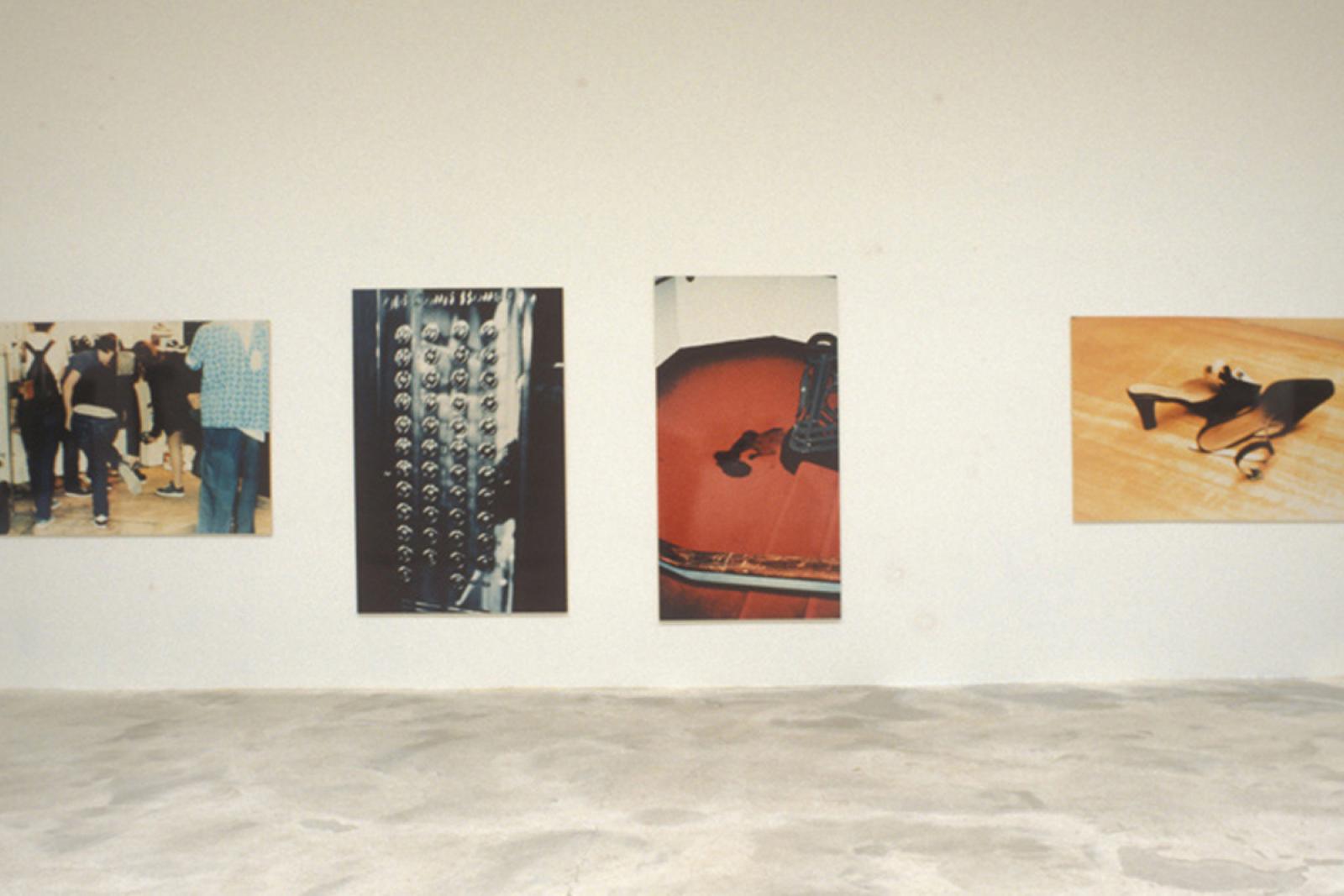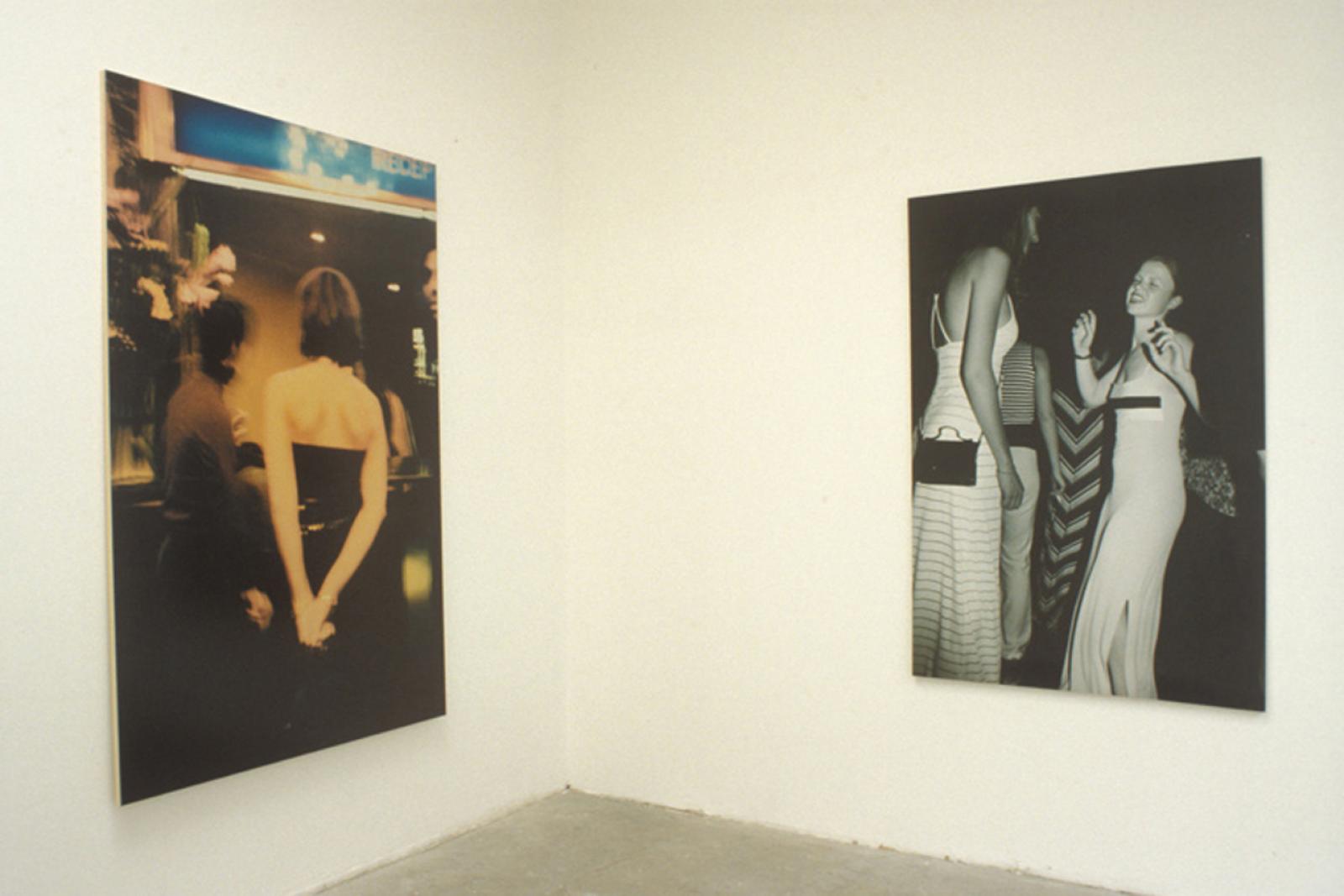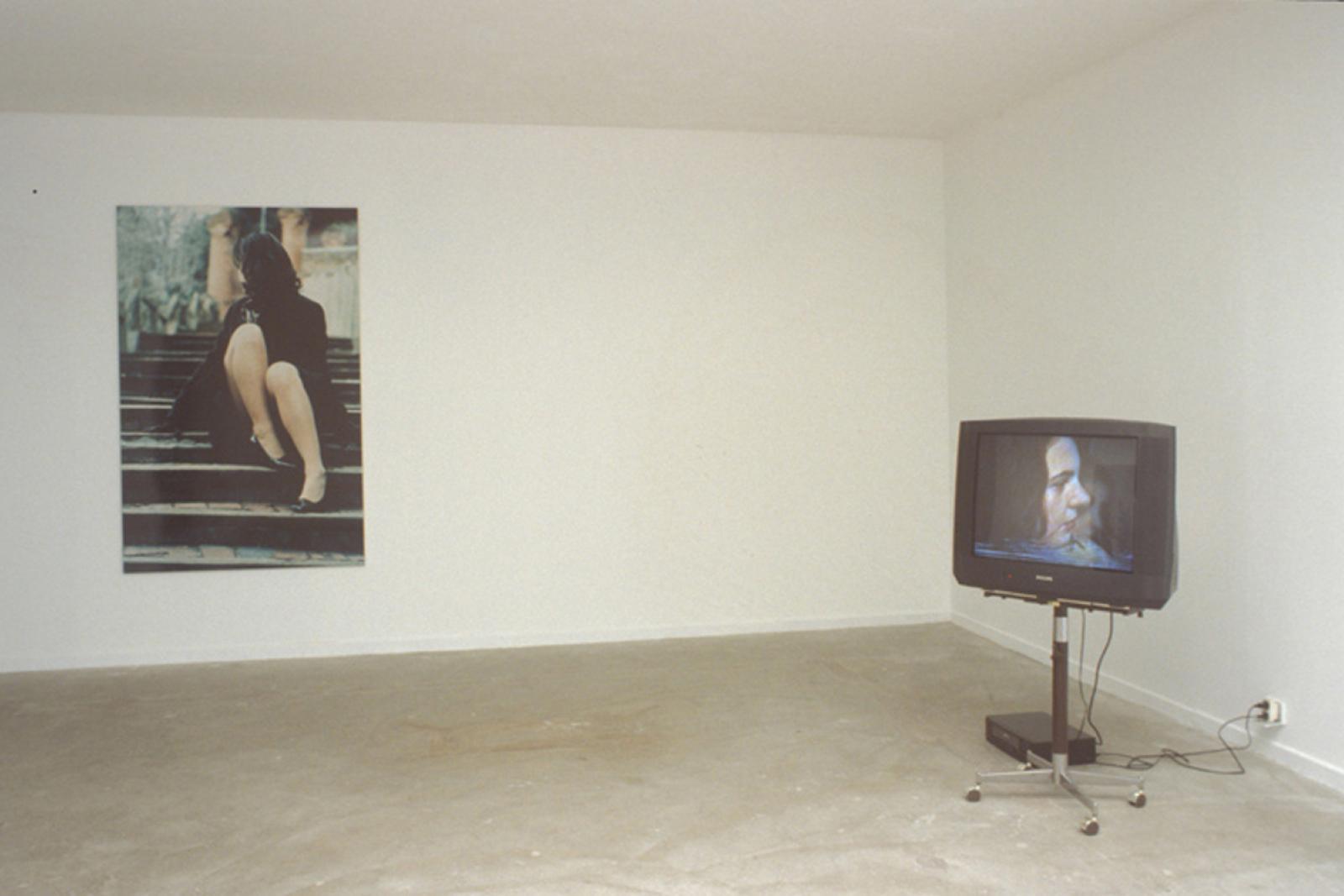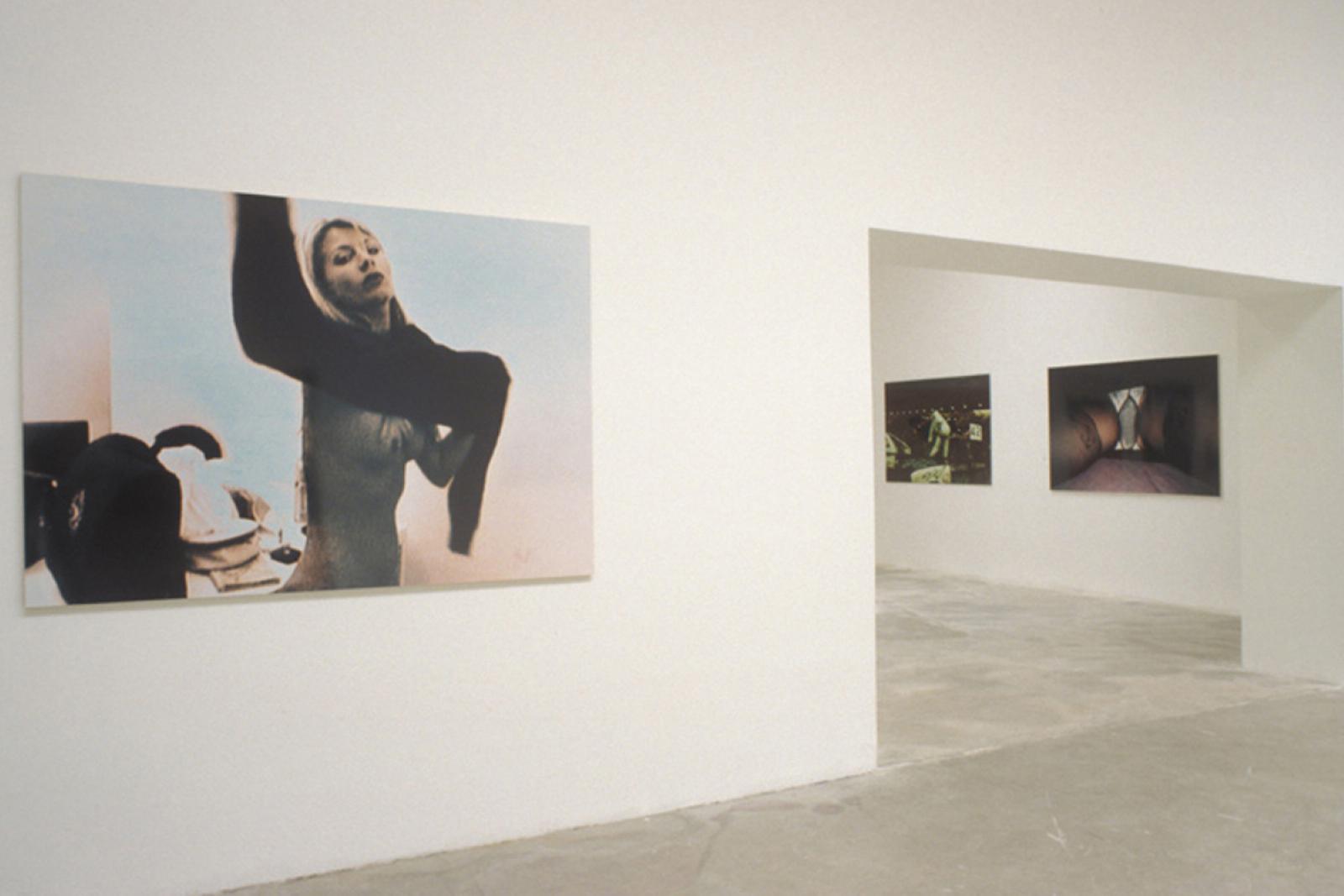Henry Bond
Henry Bond
Henry Bond (b. 1966, London. He lives in London.)
Stephan Schmidt-Wulffen : Where do you walk when setting out to photograph, what is the goal of that activity?
Henry Bond : One of the things taht occurs to me is how the form is parallel to the psychoanalytic session, in that anything can be mentioned, anything can come up and indeed what seems too minor or too stupid is precisely the key to something significant. Like the urban flow of pedestrians and traffic, it really doesn’t matter what passes through, because what is important is how you are perceiving the events. And that is often divergent from any initial aim or strategy.
Stephan Schmidt-Wulffen : But did you go on these walks with a certain intention or did you just stroll around the city to let things happen ?
Henry Bond : Often I have an aim.
Stephan Schmidt-Wulffen : Would these be places, or would it be more ideas, such as I should have a look at shopping malls. Perhaps you know a street where there are certain types of people meeting, for example ?
Henry Bond : Often I feel really want to go and take pictures in a particular shop or I feel that a certain place would be right to do some pictures, or I really want to shoot some rolls around, say, St Paul’s Cathedral or I really want to do something at the entrance of the Virgin Megastore, but actually when I look at the shot rolls of film at the end of the day, or the next day, it is the pictures that I took before or after this, which are the more interesting images, and in fact the brief was something like a pretext.
Often what I think is going to be significant can turn out to be banal, whereas what is probably more unexpected or slight, something I never expected to take a picture of, could be a point at which I may make a very surprising or revealing image.
Stephan Schmidt-Wulffen : This is actually the classical role of the flâneur who strolls through the city without having, actually, a very clear idea of where to go, but he is enjoying walking though the city and getting all these images more or less by chance. It is a very deep rooted modernist strategy because the idea of the shopping mall and the flâneur starts with people like Baudelaire and goes up to the dérive of the Situationists, so there is a whole bunch of traditions of the artist in the metropol.
Henry Bond : I think that the theme of the flâneur is significant, and it is an important reference point, particularly in the sense that my work has been an evolution of proceeding with artistic practice, artistic production, without asserting an initial theme or a thematic area that I am setting out with as pre-decided. I have tried to draw on what is local, which I thing is the idea of the flâneur engaging randomly, at will.
Stephan Schmidt-Wulffen : And it is opposed to the traditional idea of authorship where you have an idea and you stamp it on the world. The flâneur is the product of the context he is moving in. He makes himself the product of social situations.
Henry Bond : Sure.
Stephan Schmidt-Wulffen : At this moment we have to come to the question of editing. How is the sequencing in the book achieved ? Is this a composition you arrived at or is it something that follows certain topological structures ?
Henry Bond : The way I engage with the material is to try and bring back this question of the unexpected or that one type of imagery is always being asserted over another. That equally I may, at any moment, be in a nightclub or on the street, or photographing a celebrity. The value or status of a photograph is a result of how we perceive the context. One builds the context through visual or language cues and prompts that are recognisable and familiar patterns. The way one reacts to, engages with or considers an image placed over a double page spread in Vogue magazine is very different to, say, a photograph proudly proffered from a friend’s wallet.
Stephan Schmidt-Wulffen : You work hard to reinforce the insecurity of genre that you create. When one gets the idea that this might be documentary, you confront it with a photograph which contradicts this kind of idea or if there is something looking like a fashion photograph then you have something which equally contradicts that.
I think that is really important to make a division between what happens at the moment of being in the city and how you photograph and the next step when you are confronted with the material and you open the images on the computer and re-articulate the experience – then it is completely different thing. The first thing has to do with the relationship between a person, an identity and the surrounding space and the idea of what is experience ? Does one experience something or is one a product of the space and just strolling through ? Then you come to a more sophisticated, intellectual work when you articulate a photographic proposal and I feel that it is very important in your work that there is never a closure, that you never end up with a clear-cut genre of definition.
Henry Bond : I ma initially reminded of the Us photographer William Eggleston who focused his whole production on making the photograph and his attitude seemed to be the specifically reject or problematise the idea of choosing – it is like he is saying If someone wishes to come along and take some of my pictures and edit them into a book, that is their choice but, in the meantime, I just take photographs’, as far as I know, Eggleston has not been directly involved in producing the sequence of his books such as The Democratic Forest.
I am fascinated by that position as a formal strategy. However, I am working in a way which supposes that the context of an image is crucial. What is a vital and necessary dimension in my interrogation of photography is to find out how codes and conventions function and are deployed to produce photographic meaning. I think that probably the way that I have achieved some way foward in that, is to place these codes into contention, to break them and reassert them and find out where they break down, where they stop functioning.
Stephan Schmidt-Wulffen : And I think what is important about Eggleston is that for him, apparetnly, the photograph is an autonomous work, I mean if you give it away like this and say you can do whatever you want to do, then every work in itself is like a kind of machine.
For you it is different, when you talk about codes, you actually say that a singular image is nothing, but it is constituted as a referential item – like a word in a sentence – it is parr of a larger structure.
Henry Bond : Certainly, for me an image is always coloured, charged and altered by affecting its context.
Stephan Schmidt-Wulffen : When you think of a person like August Sander, then his collection of images is just a collection, the collection works like an adding up of motifs or if you think of Bernd and Hilla Becher – who might produce work by photographing every house in a certain region that is listed as dilapidated – this is not your method, because what you do is to produce not a collection of images, but a production of a certain structure, which would be different to documentary photography, where you have the idea of completeness. With your collection you do not have the idea of completeness.
What is interesting, is that you constitute a structure, you construct a kind of frame, not to fit the photographs in the frame, but to free them from the frame. There is a kind of paradoxical movement in the work you do, in a way. You have to constitute a language constructed out of different genres to show that no photo fits to these genres or types.
When you focus on a genre and you say this is apparently a documentary photograph and then with the context you create with other photographs, the viewer becomes insecure as to whether this is really documentary or not. What you do is to put a question mark over the relationship of the photographer towards reality, for instance, there is a photograph of a nude woman, you don’t think so much about the woman but about the genre : the pin-up genre in this case. It’s not so much about that individual woman, but about the relationship of the viewer to naked women in general and at this point you wonder what is your role as a photographer. Did you do this as an artist, or perhaps in the role of a lover or as a fashion photographer ? By constituting my relationship to the photograph I have to constitute a fictitious relationship between you and the photograph.
Henry Bond : And presumably, that often leaves a gap.
Stephan Schmidt-Wulffen : Yes, absolutely. If one proposes that the genre is in question, then it is not certain what your role is : there is a basic ambivalence in every photograph you have here. An ambivalence that is present for structural reasons.
Henry Bond : I encounter images in a way which is fractured and not defined. I try to reflect that in my approach, I feel that I should not divest myself of that responsibility. In a certain way that is why I started taking photographs in clubs and bars or engaging with the language of glamour photography, because these fields are crucial to the way photography functions : images of idealized pleasure, images of idealized beauty.
When I am photographing in a club people often come up to me and see if I need picture of them or they request that I make a picture of them : Why don’t you do a picture of us ? Sometimes I agree and the next thing that will happen, when I bring the camera to my eye, quite suddenly, they will almost without exception assert this codified pose of hanging their tongues out – like a dog panting – or a kind of mad screaming grimace, rolling their eyes, demented. I might say. That was great and now, just be yourself, and then the image will change to a kind of bored, slightly vacant and disinterested pose. My point is that even the idea of a simple, neutral or objective image is a representation, controlled and manipulated even when it seems to be just a straightforward picutre in a club.
Stephan Schmidt-Wulffen : The language of photography has already arrived in people’s minds and what they do is a kind of photography without the photograph.
Henry Bond : Yes, that is a specific example but it stands as a general point, what I am dealing with is the thoughts and feelings which we are already affected by well before anyone takes a photograph, even if these values or wishes may only be distilled or refreshed in that moment.
There is in the book an interplay and juxtaposition between confrontation to the camera and sureveillance. The pose and the facial expression against images made without the subject’s knowledge, images that are often proposed as candid revealing something different to what the pose – the idealized representation – can reveal.
Recently the role of intrusive photography and The Paparazzi has been discussed widely, but equally a defining quality of contemporary street culture is the presence of security surveillance cameras, which are now installed at intervals along shopping streets as a typical and agreed part of police activity.
What I am putting forward is that in interrogating the language of photography, it is not my ambition to arrive at a conclusion or an answer but an artistic and creative engagement with these issues. In this sense I have found much to examine and admire in the work of Kippenberg or Sigmar Polke, in the sense that there has not to be something like a formal ritual, only there is always the questioning of the structure of what will make a good art work, and that there is no simple answer there.
Stephan Schmidt-Wulffen : No answer at all, because you construct the conditions under which something might be a good one and if you change the conditions, a good one could be a bad one. And this is very much true about the work of Kippenberg, he was aware of this complete relativity and what is interesting about the work is that you have to know the language, and if you get into the language it is really great. And he is suffering because a lot of people did not understand this…
Henry Bond in conversation with museum director Stephan Schmidt-Wulffen
in catalogue The Cult of The Street, édition Emily Tsingou Gallery



